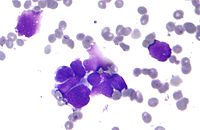
Photo from wikipedia
Simple Summary Immune checkpoint inhibitor (ICI) therapy has proven effective for many cancer patients, but predicting which patients with renal cell carcinoma (RCC) will respond has been challenging. We analyzed… Click to show full abstract
Simple Summary Immune checkpoint inhibitor (ICI) therapy has proven effective for many cancer patients, but predicting which patients with renal cell carcinoma (RCC) will respond has been challenging. We analyzed clinical characteristics and molecular parameters of a cohort of patients with RCC treated with anti-programmed death 1 (PD-1)/PD-L1 therapy to determine factors that correlate with patient outcome. We found that the composition of circulating immune cells in the blood, development of immune-related toxicities, and gene expression patterns within the tumor correlate with patient response. In addition, we see that high expression of PD-L1 and lower numbers of unique T cell clones in RCC tumors are associated with improved survival. In summary, our findings corroborate previously published work and introduce new potential factors impacting response to ICI therapy that deserve further investigation. Abstract Predicting response to ICI therapy among patients with renal cell carcinoma (RCC) has been uniquely challenging. We analyzed patient characteristics and clinical correlates from a retrospective single-site cohort of advanced RCC patients receiving anti-PD-1/PD-L1 monotherapy (N = 97), as well as molecular parameters in a subset of patients, including multiplexed immunofluorescence (mIF), whole exome sequencing (WES), T cell receptor (TCR) sequencing, and RNA sequencing (RNA-seq). Clinical factors such as the development of immune-related adverse events (odds ratio (OR) = 2.50, 95% confidence interval (CI) = 1.05–5.91) and immunological prognostic parameters, including a higher percentage of circulating lymphocytes (23.4% vs. 17.4%, p = 0.0015) and a lower percentage of circulating neutrophils (61.8% vs. 68.5%, p = 0.0045), correlated with response. Previously identified gene expression signatures representing pathways of angiogenesis, myeloid inflammation, T effector presence, and clear cell signatures also correlated with response. High PD-L1 expression (>10% cells) as well as low TCR diversity (≤644 clonotypes) were associated with improved progression-free survival (PFS). We corroborate previously published findings and provide preliminary evidence of T cell clonality impacting the outcome of RCC patients. To further biomarker development in RCC, future studies will benefit from integrated analysis of multiple molecular platforms and prospective validation.
Journal Title: Cancers
Year Published: 2021
Link to full text (if available)
Share on Social Media: Sign Up to like & get
recommendations!